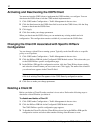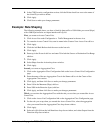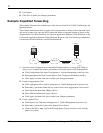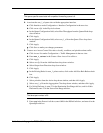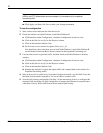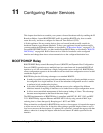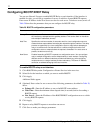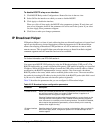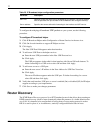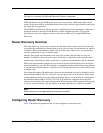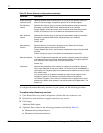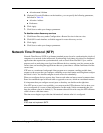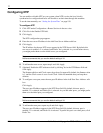
Nokia Network Voyager for IPSO 4.0 Reference Guide 471
To disable BOOTP relay on an interface
1. Click BOOTP Relay under Configuration > Router Services in the tree view.
2. Select Off for the interface on which you want to disable BOOTP.
3. Click Apply to disable the interface.
When you click off, then apply, the BOOTP relay parameters (primary IP, wait time, and
new server) disappear, however the parameters are still stored in the system. If you select
On, then Apply, these parameters reappear.
4. Click Save to make your changes permanent.
IP Broadcast Helper
IP Broadcast Helper is a form of static addressing that uses directed broadcasts to forward local
and all-nets broadcasts to desired destinations within the internetwork. IP Broadcast Helper
allows the relaying of broadcast UDP packets on a LAN as unicasts to one or more
remote servers. This is useful when you relocate servers or hosts from their original
common segment and still want the service to be available.
Note
For further information, see RFC1542 section 4.
You cannot pass BOOTP UDP packets by using the IP Broadcast helper (UDP port 67). The
BOOTP functionality on a router is different from generic UDP packet forwarding to a specified
IP address. While the IP Broadcast Helper forwards the UDP packet to the IP address without
modification, the BOOTP implementation is more complex—the client sends a broadcast
BOOTP packet to the router, which sends a modified packet to the server. The router modifies
the packet by inserting its IP address in the giaddr field of the BOOTP packet (this field is used
by the server to identify the network where the packet originated).
Table 29 describes the parameters that you can configure for IP broadcast helper.
Table 29 IP Broadcast helper configuration parameters
Parameter Description
Forward Nonlocal Allows you to forward packets that are not originated by a source that is directly on
the receiving interface. When you enable Forward Nonlocal, it applies to all
interfaces that are running the IP Helper service.
Selecting Disabled requires that packets be generated by a source directly on the
receiving interface to be eligible for relay. Enabled allows forwarding of packets
even if the source is not directly on the receiving interface. The default is Disabled,
which requires that packets be generated by a source directly on the receiving
interface to be eligible for relay.
IP Helper Interface
On/Off
Specifies whether IP helper service is running on the interface. After you select On
and click the Apply button, configuration options for IP broadcast helper for the
interface appear.




